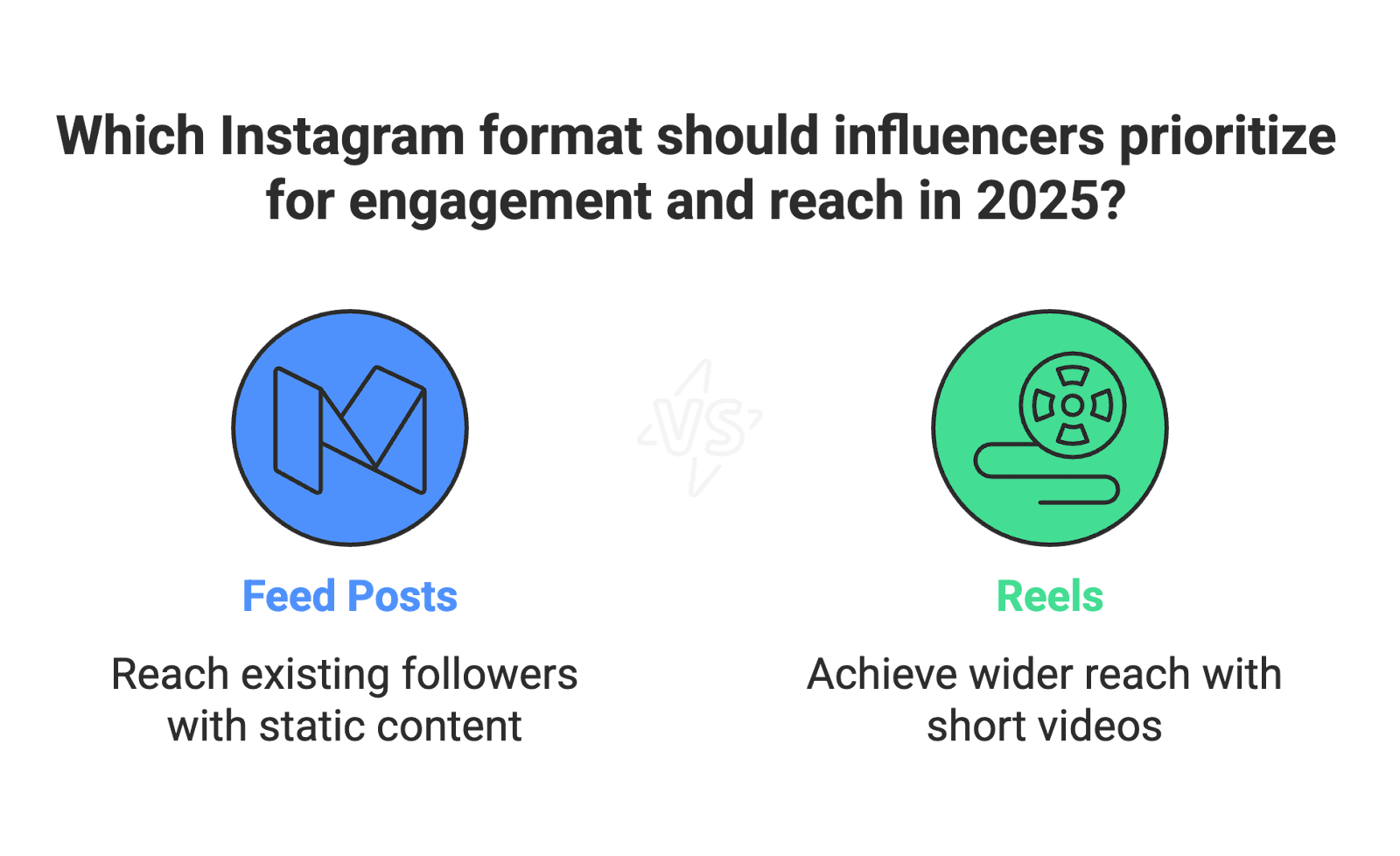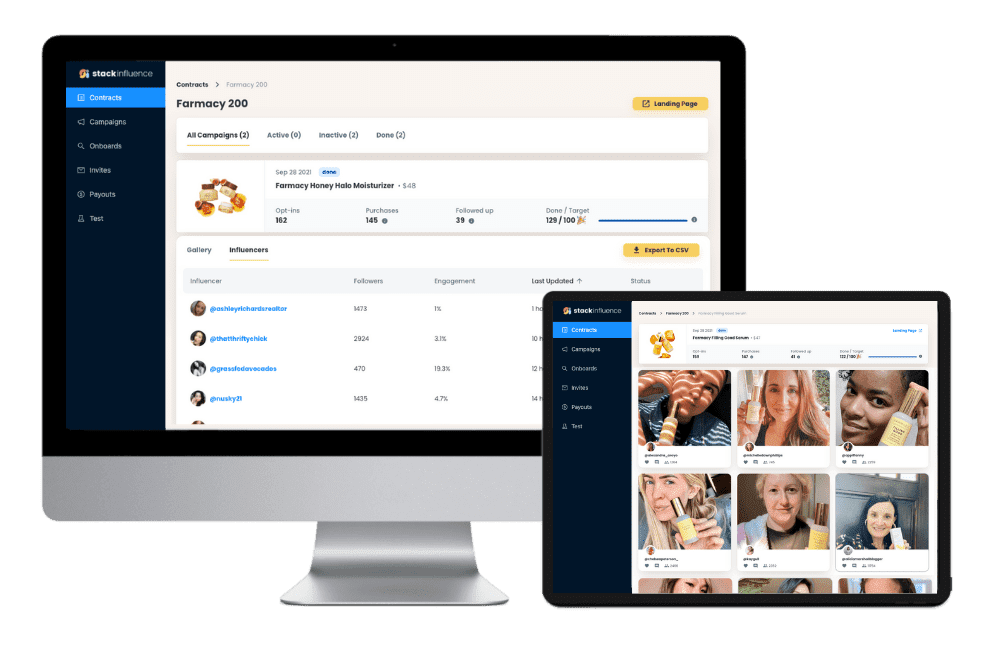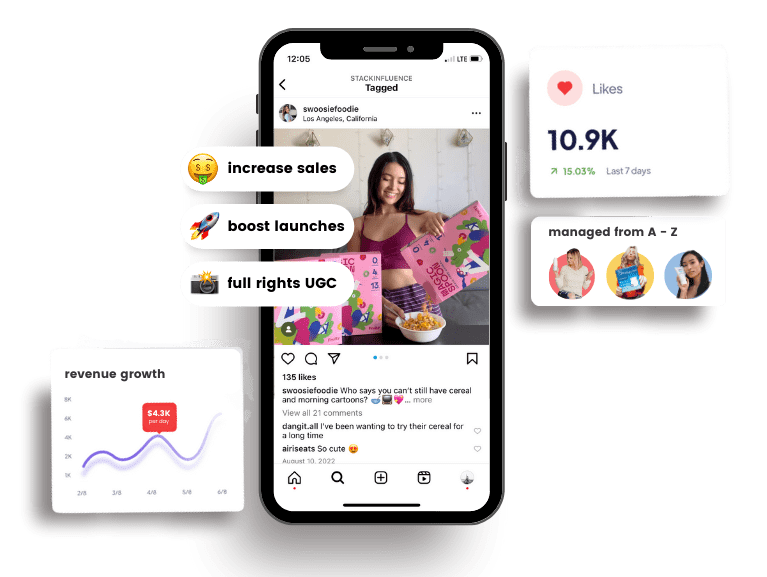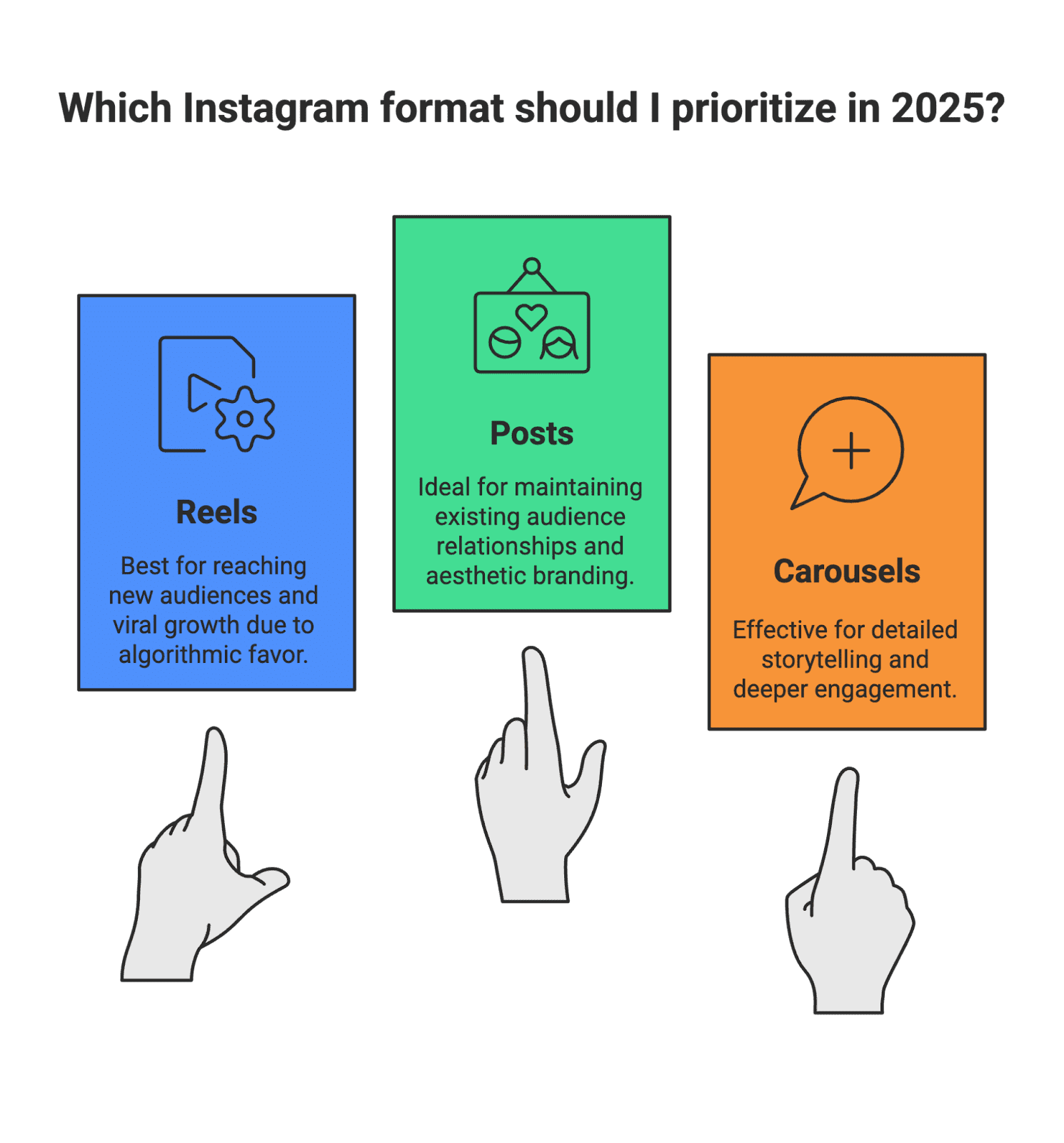Instagram Posts vs. Reels: Which Is Better for Influencers in 2025?
1st
October, 2025
Influencer Marketing
Amazon Marketplace
Artificial Intelligence
TikTok Tips
Instagram’s content landscape has evolved dramatically, and influencers in 2025 are often asking: Should I focus on traditional posts or lean into Reels? Both formats have their strengths and serve different purposes. In this article, we’ll break down how feed posts and Reels differ – from how they work and how audiences engage with them, to how Instagram’s algorithm treats each format. We’ll also look at up-to-date 2025 stats on reach, engagement, and growth to figure out which format might perform better for today’s influencer.
Let’s dive into the Posts vs. Reels showdown, with a casual but data-driven look at what’s trending now.
Format 101: Feed Posts vs. Reels

Feed Posts on Instagram include the classic images or carousel albums (multiple images/swipes) that appear on your profile grid and followers’ main feeds. Posts can be photos or graphics (and sometimes videos, though most video content is now funneled into Reels). Influencers often use posts for curated, high-quality images, meaningful captions, or informational carousels. This format is great for storytelling or sharing static visuals – for example, a carousel might showcase multiple angles of an outfit or a step-by-step recipe. Users browsing the feed typically see posts from accounts they follow, and occasionally suggested posts. Discovery for feed posts often relies on hashtags, Explore page, or sharing, but reach beyond your followers can be limited unless a post performs exceptionally well (e.g. lands on Explore).
Reels, on the other hand, are Instagram’s short-form vertical videos (up to 90 seconds, usually) that mirror the TikTok style. Reels are discoverable in a dedicated Reels feed (accessible via the Reels tab) and are heavily pushed to users – even those who don’t follow you – via Instagram’s algorithm. They often include music or trending audio, quick cuts, captions or stickers, and an attention-grabbing hook in the first seconds (since viewers tend to swipe quickly if not engaged). Reels are meant for entertainment, virality, and quick storytelling. Features like remixing (duets) and the ability to share Reels to Stories or direct messages make them highly shareable. In 2025, Reels have become central to Instagram’s experience – by some reports, over 90% of Instagram users now interact with Reels content regularly. Instagram has effectively integrated Reels into the main feed as well, so you’ll see Reels mixed in with photos when scrolling your home feed. For influencers, Reels offer a chance to reach a much broader audience through the app’s recommendations.
In short: Posts are the traditional “static” content that primarily reach your existing followers (plus a bit of Explore visibility), whereas Reels are short videos designed for discovery and wider reach. Next, let’s look at how people consume these formats differently.

Unlock the Power of Micro Influencers and Elevate your Brand Today!

Audience Behavior: How Followers Engage with Posts vs. Reels
Audience habits on Instagram have shifted towards video in a big way. Scrolling the feed to see friends’ and creators’ latest photo posts is still common, but users increasingly treat Instagram like a video platform. In fact, as of early 2024 Instagram’s own data showed users now spend 50% of their time on Instagram watching Reels. That’s a huge share of attention going to short-form videos. Many users fall into the endless scroll of the Reels feed for entertainment, much like TikTok’s feed. By contrast, static posts (photos/carousels) don’t command that same time spent metric – they’re viewed more quickly as users scroll by in the feed.
Engagement pattern differences are notable. On a typical photo post, a follower might stop to read the caption, tap like, or leave a comment, especially if the caption asks a question or the content resonates. Carousels often encourage longer attention per post (as people swipe through 5-10 images) and can prompt saves or shares for later reference (for example, a carousel with tips or infographic gets saved a lot). In fact, carousel posts have been known to drive more saves and dwell time, which is a positive signal to the algorithm. Reels, however, often prompt quick reactions – a double-tap if it’s funny or impressive, maybe a quick comment or tagging a friend, or frequently a share via DM/Story. Because Reels are highly shareable and remixable, a funny or relatable Reel can spread fast through private shares. Instagram even noted that remix and share features on Reels amplify their reach beyond the original audience as users repost Reels to their Stories or send them to friends. The viral nature of Reels means audiences use them not just to consume content, but to discover new creators and trends (think dance challenges, memes, or product reviews going viral).
Another behavioral difference is audio: Reels are often watched with sound (or at least with music captions on), and trending audios can attract viewers. Many users will scroll Reels with the sound on or use the closed-caption text, whereas feed posts are silent and rely solely on visuals and text. This means Reels can hook viewers with music or voice – adding to engagement if done right.
It’s also worth noting audience demographics: younger users (Gen Z, young Millennials) are especially drawn to short-form video. Surveys have found that short videos (under 15 seconds) are a top content preference when interacting with brands, with static images still holding their own as well. This suggests audiences enjoy a mix: the quick hit of a video and the clarity of a good photo. For influencers, balancing both can cater to different viewer preferences – videos for entertainment and broad reach, and images for depth and context.
Algorithmic Treatment: Does Instagram Favor Reels?
One of the biggest differences between posts and Reels is how Instagram’s algorithm treats them. Instagram in 2025 actually runs multiple algorithms for different sections (Feed, Stories, Explore, Reels). Reels have a separate ranking algorithm focused on maximizing engagement and watch time, whereas feed posts (photos/carousels) use another that emphasizes relevance to the user.
That said, Instagram has very clearly been pushing Reels content in recent years. The platform openly admitted in 2023 that it adjusted its recommendation system to boost Reels – a move that paid off by increasing time spent on Instagram by 24% once the Reels algorithm improvements rolled out. In practice, this means if you post a Reel, Instagram is more likely to show it to people who don’t follow you yet if the Reel seems to be resonating (high engagement, watch time, etc.). Reels get priority placement in the Explore grid and, of course, in the Reels tab – so they have multiple surfaces to be seen. Instagram’s algorithm explicitly favors Reels: the app will serve Reels “more frequently than it would for photos,” even to users who aren’t following the creator. Essentially, Instagram rewards creators for posting Reels by granting extra exposure. They even made it easy to cross-post Reels to Facebook for additional reach.
Feed posts, by comparison, are mostly shown to your followers and a smaller pool of suggested viewers. The feed algorithm looks at a user’s past interactions and interests to recommend some posts (including carousels and photos) that they might like. But these suggestions are typically from similar accounts or topics the user has shown interest in – it’s a bit more conservative than the wide viral push Reels can get. For a feed photo to reach a non-follower, it likely needs a strong engagement signal (getting a lot of likes/comments quickly) so that it might appear on Explore or as a suggestion because it’s “going viral” in its own right. Reels, on the other hand, are designed to go viral more easily; Instagram looks at indicators like how quickly people are interacting with a Reel and will ramp up its distribution if it’s performing well.
In 2025, Instagram’s head Adam Mosseri even hinted that “views” might become a key metric – indicating that content which gets more eyes (not just likes) will be rewarded. Reels naturally accumulate tons of views if they catch on, so this shift again aligns with favoring short-form video. The bottom line: Algorithmically, Reels have an edge in reach. Instagram’s tech is literally built to push engaging Reels to as many people as possible (to keep users scrolling). Posts can certainly still travel (especially carousels with high save rates, or posts from accounts you often interact with), but they don’t have the same built-in boost to strangers’ feeds that Reels do.
Reach and Discoverability: Reels Cast a Wider Net
If your goal is to reach as many people as possible, Reels are generally the star of the show. The data backs this up: A recent Socialinsider study found that Instagram Reels have an average reach rate around 30.8%, which is roughly double the reach of carousel posts (~14.5%) and more than double that of static images (~13.1%). In plain English, a typical Reel is shown to nearly one-third of your followers (and often many non-followers too), whereas a photo post might only hit about one-seventh of your follower list. Instagram even reported in 2024 that short-form videos are the fastest way to grow an audience on the platform – precisely because of their superior reach and discovery potential.
Why do Reels reach more people? It’s partly the algorithmic favoritism we discussed, and partly the multiple discovery channels. Reels can appear in the Reels tab feed of endless videos, on the Explore page, via hashtag searches, and get shared between users extensively. A photo post mostly sits in the feed of your followers unless it’s picked up by the Explore page. Instagram’s design makes Reels inherently more discoverable – they even show Reels to users who don’t follow the creator far more frequently than they show random photos. Consider that by 2025, Instagram reports over 2 billion users engage with Reels monthly, with 140 billion+ Reels views each day. Those numbers indicate a massive pool of viewers that you can tap into with a single great Reel.
It’s also interesting to see how reach scales with your account size. For smaller influencers or brands, Instagram seems to level the playing field a bit with Reels. Micro-influencers often get a higher relative reach than huge accounts. For example, one study showed that accounts with under 5K followers got about a 20% reach rate on their Reels (i.e. views equal to 20% of their follower count on average), whereas accounts with over 100K followers got only around 4% reach in proportion. In other words, a small creator might more easily hit a big chunk of their niche audience (and beyond), while big creators don’t automatically get all their millions of followers seeing every Reel. Instagram is likely doing this to help newer or smaller creators break through.
Feed posts, comparatively, tend to have lower reach rates across the board. Many influencers notice that a standard photo post might “die” pretty quickly — it goes out to your followers, maybe picks up some hashtag views, and then plateaus. In fact, organic reach on Instagram has been challenging in general. There was about a 28% drop in overall Instagram engagement from 2023 to 2024 (people interacting less with posts), which means the average post in 2024 just doesn’t go as far as it did before. Instagram is crowded and competitive. But Reels are the exception to some extent, because Instagram is actively surfacing them to keep users hooked.
For content discovery, especially important in influencer marketing (finding new followers or shoppers), Reels are king. Roughly 70% of Instagram users use the platform for product discovery now, often via influencers and trending content – and Reels play a big role in that journey. Think of how many times you’ve discovered a new recipe, a fashion item, or a travel destination because a Reel for it went viral. The audio trends and hashtags on Reels make them easy to stumble upon. A beauty influencer’s Reel using a new makeup palette can blow up and reach people who follow similar beauty hashtags or who watch other makeup videos, even if they’ve never heard of that influencer before. In contrast, an image of the same makeup look might primarily reach that influencer’s existing followers unless it’s somehow featured on Explore.
To sum up, if reach and visibility are what you’re after, Reels provide a bigger fishing net in 2025. They are the discovery engine of Instagram right now. But reach is only part of the story – what about engagement and the depth of interaction each format gets? Let’s compare that next.
Engagement and Interaction: Short-Form Video vs. Static Content
Engagement can be measured in many ways (likes, comments, shares, saves, etc.), and both posts and Reels have their own engagement dynamics. Overall, short-form video content tends to spark a lot of interaction. By certain measures, Reels are the most engaging content type on Instagram as of 2024. For example, Sprout Social’s data shows that among influencer posts, Reels earn the highest engagement rate – about 2.08% on average – compared to 1.17% for photo posts. Carousels came in around 1.7% in that study, which is also strong but still a bit lower than Reels. These numbers indicate that audiences tend to interact more (proportionally) with Reels. People might be double-tapping, commenting, and sharing videos more readily than static images. It aligns with the idea that short videos are capturing audience attention and interest – viewers find them more immersive or compelling, hence the extra engagement.
Interestingly, other analyses that include brand accounts found carousels slightly overtaking Reels in pure engagement rate (likely due to those extra saves and swipe interactions on carousels). For instance, one report noted carousels averaged about a 0.55% engagement rate vs. 0.50% for Reels in 2024 – a tiny difference, essentially showing both formats do well. Static single images lagged behind at ~0.45%. The key insight here is that Reels and carousel posts are your best bet for strong engagement, while single photos have become the lowest-engaging format on average. Reels’ edge in engagement often comes from their entertainment value – a captivating Reel can rack up not just likes, but also a ton of comments (some studies found Reels generate more comments than other post types). Viewers might tag friends in the comments of a funny Reel or ask a question about something shown in the video. With images, comments still happen (especially if you prompt with a question in the caption), but the viral/comment culture is stronger on Reels.
Let’s not discount what carousel posts can do, though. Carousels often pack informative or storytelling content that encourages people to spend time and engage. A well-crafted carousel can actually outperform a mediocre Reel. In fact, in a Buffer study, carousels slightly edged out Reels in total interactions on average (possibly because each swipe and the time spent count as positive signals). Carousels get saved a lot – think of infographic carousels or step-by-step guides that people bookmark. So, while Reels might win in broad engagement and virality, carousels can drive deeper engagement from your core followers (saves, long comments, etc.). It’s notable that carousels also remain a favorite for many brands in certain niches (e.g. food blogs might post recipe carousels more than Reels, as their audience likes to bookmark the steps).
Another aspect of engagement is how authentic or connected the interaction is. Some influencers feel that while Reels get more volume of engagement, the interactions on static posts can be more meaningful (e.g. a thoughtful comment on a life update photo vs. a bunch of laughing emojis on a comedic Reel). Depending on your goals, that might matter. But from a pure metrics standpoint, in 2025 short-form videos are proving to drive hefty engagement numbers. Instagram themselves have observed that Reels and Stories are the video formats people engage with most, and they encourage creators to prioritize those for better results.
One more thing to consider: consistency and burnout. Because Reels reward high engagement, some influencers churn out lots of Reels to maintain that momentum. But making quality video content can be more time-intensive than snapping a photo. Audience engagement will drop if your Reels feel repetitive or low-effort, so finding a sustainable content process is key. Some influencers mix it up – e.g. use Reels to hook new followers and entertain, and posts (images/carousels) to build connection, share personal stories or detailed info. This diversified approach can keep your overall engagement healthy without relying solely on one format.
Virality and Growth Potential
From the perspective of going viral and gaining followers, Reels have a clear advantage in 2025. The virality mechanics of Instagram heavily favor Reels – their content is easily shareable and remixable, meaning one good idea can snowball into thousands of new eyes on your account. For example, an influencer could have a Reel blow up to 1 million views thanks to the Reels algorithm showing it on countless Explore pages and Reels feeds. It’s common to hear stories like “I gained 5,000 followers overnight because one of my Reels went viral.” This kind of explosive growth is much less common with a standard photo post in the current Instagram environment.
There are a few reasons Reels convert to follower growth well. First, when a Reel is shown to a non-follower, your username is right there and they can easily tap through to your profile. If your profile has an appealing vibe and more good content, that view can turn into a follow. Second, Reels often showcase personality – through video, viewers get a sense of you (your voice, humor, expertise, etc.) which can create a stronger connection than a static image might. That connection can motivate someone to hit the follow button for more. Instagram has explicitly noted that it wants to use Reels as a way to help creators gain exposure; they’ve called short-form video the fastest-growing content for audience building.
Follower conversion from Reels can depend on content type, of course. A quick meme Reel might get tons of laughs and shares but not necessarily targeted followers for your niche. Meanwhile, a Reel where you, say, give a valuable travel tip could attract people interested in travel who then follow you for more. The good news is that the algorithm tends to show your content to users who have shown interest in similar topics (it’s looking at “information about the reel and the person who posted” to find relevant viewers). So a viral Reel often finds a relevant audience who is more likely to convert.
With feed posts, virality is tougher. It’s not impossible – for instance, a breathtaking photo might go viral on the Explore page or a carousel of useful info might get shared widely. But those are exceptions rather than the norm on Instagram now. The typical path to growth via posts is slower and steadier: you post consistently quality content, use hashtags, maybe get shouted out by larger accounts or collaborate, and gradually accumulate followers. Reels can accelerate that process dramatically by throwing your content into many more feeds in a short time.
In terms of raw statistics for growth, smaller accounts (nano-influencers) have seen some of the highest growth rates on Instagram recently – partly by leveraging Reels. One study found that the smallest Instagram accounts (under 5k followers) could grow their follower count by up to 38% year-over-year (a reflection that there’s opportunity to climb when you’re starting from a low base). Those who strategically used Reels as part of their content mix likely contributed to that stat. Also, over 53% of marketers in the U.S. said they used Instagram Reels in their influencer marketing campaigns in the past year, indicating that brands want the viral reach of Reels when partnering with influencers. It often means if you’re an influencer, being adept at Reels makes you more attractive for collaborations (because brands see the potential for bigger reach and impact).
Virality isn’t just about follower numbers, though. It also translates to influence and sometimes revenue. A viral Reel can drive traffic to a link (say you mention “link in bio”) or boost product sales if it’s a product highlight. The short-form format can create trends (how many products have sold out because they went viral in a Reel/TikTok?). So for influencers concerned with being effective marketers, Reels offer that upside of trend-making virality, whereas a static post is less likely to have that immediate “explosive” impact.
However, with virality comes volatility. Not every Reel will perform, and relying on viral hits can be a rollercoaster. Some Reels might flop or only reach your core followers. Instagram’s saturation of Reels means there’s also fierce competition – there are so many videos out there now. In fact, by late 2024 the influx of Reels led to a bit of saturation: Reels engagement plateaued slightly as more creators flooded the format. This suggests that while Reels are still a top growth tool, influencers need to keep their quality high and perhaps find a niche or creative twist to stand out.
Which Format Should Influencers Prioritize in 2025?

Both posts and Reels have a place in a well-rounded Instagram strategy, but their roles are different. Here’s a quick comparison and some guidance for influencers trying to decide where to put their effort:
- Reach & Discovery: Reels are the clear winner. If your aim is to get in front of new eyeballs and grow your follower count, you should be creating Reels. The algorithm is on your side here – Instagram literally shows Reels to people who don’t follow you far more readily than it will with photo posts. A good Reel can exponentially increase your exposure, whereas a great photo might still stay relatively contained.
- Engagement: Reels and carousels both drive strong engagement. Reels often get quick, high-volume interactions (views, likes, comments) indicating audience excitement. Carousel posts encourage depth – multiple slides, longer caption reads, and saves. If you want quick engagement spikes and shareability, do Reels. If you want slower-burning engagement that might indicate deep interest (like people saving your content or leaving thoughtful comments), a carousel or well-crafted image can achieve that. Many successful influencers use Reels to “hook” the audience and then follow up with posts that provide value or personality, fostering a loyal community.
- Audience Connection: Static posts (images) are still very useful for maintaining your relationship with existing followers. They’re great for announcements, personal updates, or polished brand content. Your core fans will appreciate these posts in their feed, and the consistency helps maintain your presence. Reels might bring people in, but posts often keep people around by showing who you are in a different way (not every message fits into a 30-second video). There’s also the aesthetic factor: many influencers care about their Instagram grid appearance – beautiful photos and a consistent style which showcase their brand. Posts are the vehicle for that curated aesthetic, whereas Reels live in their own tab and don’t disrupt your grid’s look.
- Growth Potential: If we’re talking pure follower growth and viral potential, prioritize Reels. Short-form video is simply the growth engine on social media right now (on Instagram and elsewhere). As one marketer put it, Instagram Reels currently “see the highest reach and engagement among all other media types” on the platform. The trend is clear that video is where growth is happening. In fact, as of 2025 over half of content published by Instagram creators are now Reels – meaning if you’re not doing it, many of your peers (and competitors) are.
- Influencer Partnerships: Brands in 2025 often request Reels as part of influencer campaigns (to leverage that algorithm boost). If you’re working with brands, expect that they might want a Reel deliverable because Reels can yield higher reach and often higher engagement rates (e.g. 2% vs <1% for some posts), which makes the campaign look good. That said, carousels are also valued for things like detailed product showcases or multi-frame storytelling. A savvy influencer might offer a package: a Reel for reach + a carousel post for depth + perhaps Stories for real-time engagement. Mixing formats can cover all bases.
Trends to watch: Content discovery via short video isn’t slowing down. Features like in-app shopping and product tagging on Reels mean they’re not just for laughs – they can drive commerce too. Also, Instagram’s continued competition with TikTok means we might see even more features to boost Reels (or maybe monetize them better for creators). Staying on top of Reels trends (like new editing tools, popular sounds, challenges) will help maintain that high performance. Meanwhile, traditional posts might continue to see modest engagement declines, so those who innovate (e.g. creating mini-infographics, leveraging carousel swipes creatively) will keep that format alive and well.

Unlock the Power of Micro Influencers and Elevate your Brand Today!

Conclusion to Instagram Posts vs. Reels
For influencers in 2025, short-form video is a must-have in your toolkit. Instagram is clearly favoring Reels in how content is distributed and consumed. Reels offer superior reach, strong engagement, and the chance to go viral and boost your growth. However, this doesn’t mean you should abandon traditional posts entirely. Photos and carousels still play a crucial role in storytelling, branding, and connecting with your core audience. The best strategy is often a balanced mix: use Reels to reel people in (pun intended) and use posts to cement your relationship and provide value that might not be as easily delivered via a quick video.
By understanding the strengths of each format, you can tailor your content strategy to get the best of both worlds. In 2025, an influencer who masters both engaging Reels and compelling posts will likely see the greatest payoff – growing their audience while keeping it genuinely engaged. Good luck, and happy ‘gramming with your posts and Reels!

By William Gasner
CMO at Stack Influence
William Gasner is the CMO of Stack Influence, he's a 6X founder, a 7-Figure eCommerce seller, and has been featured in leading publications like Forbes, Business Insider, and Wired for his thoughts on the influencer marketing and eCommerce industries.
Want new articles before they get published? Subscribe to our Awesome Newsletter.
stack up your influence
turning creativity into currency
our headquarters
111 NE 1st St, Miami, FL 33132
our contact info
[email protected]
stack up your influence
turning creativity into currency
our headquarters
111 NE 1st St, 8th Floor
Miami, FL 33132


